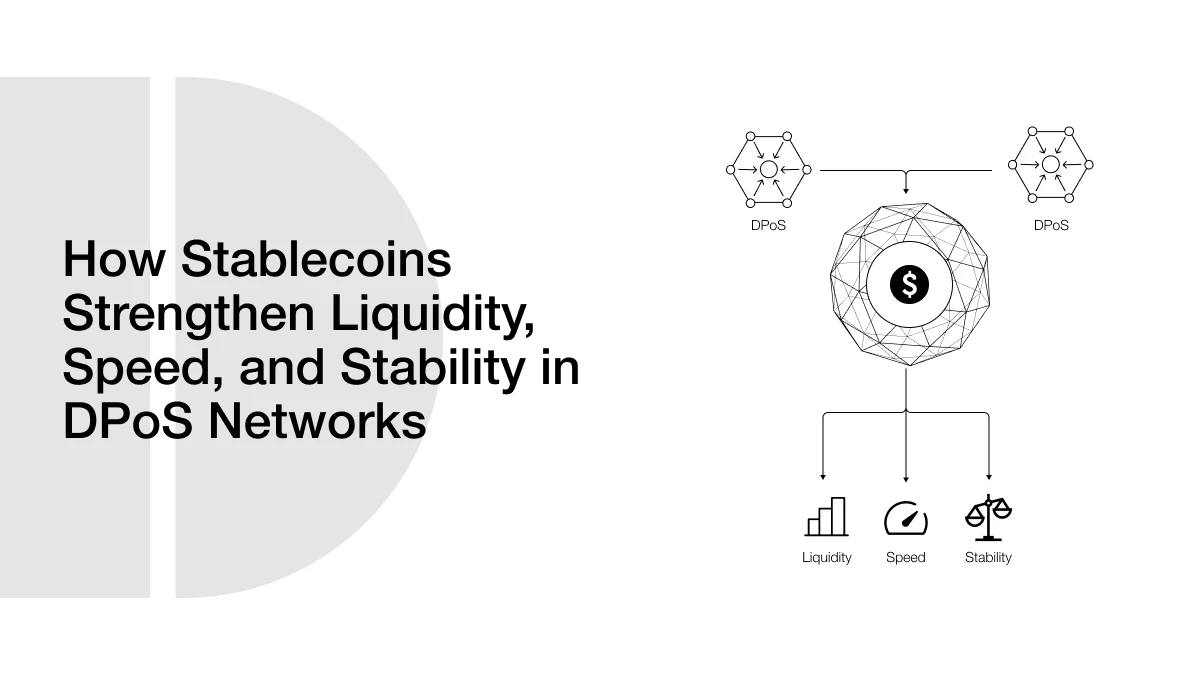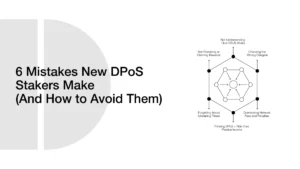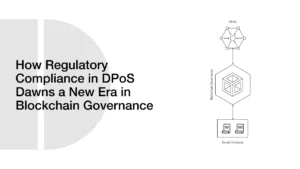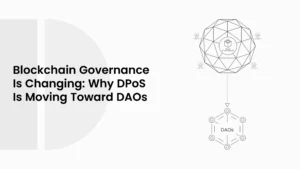How Stablecoins Strengthen Liquidity, Speed, and Stability in DPoS Networks

Stablecoins and Delegated Proof of Stake (DPoS) are two parts of the crypto world that work well together. Stablecoins give price stability. DPoS gives fast and energy-efficient blockchain performance. When they are combined, they can make blockchain networks more liquid, more predictable, and easier for people to use.
- Understanding Stablecoins and DPoS Basics
- What Are Stablecoins?
- Quick Look at Delegated Proof of Stake
- Why Stablecoins and DPoS Fit Together
- How Stablecoins Improve Liquidity in DPoS Networks
- Stablecoins in Staking Pools
- Liquidity for Validators and Delegates
- Comparing Liquidity With and Without Stablecoins in DPoS
- Stablecoins for Cross-Chain Liquidity in DPoS Ecosystems
- Why Cross-Chain Matters for DPoS
- Role of Stablecoins in Multi-Chain Swaps
- Example Cross-Chain Transaction Speeds With Stablecoins vs Volatile Tokens
- Risk Management—Stablecoins as a Safety Net in DPoS
- Hedging Against Market Volatility
- Reducing Counterparty Risk
- Risk Levels in DPoS Without vs With Stablecoin Integration
- Real-World Use Cases of Stablecoins in DPoS Platforms
- Case Study – EOS and USDT Liquidity
- Case Study – TRON’s USDD and Cross-Border Payments
- Challenges of Using Stablecoins in DPoS Models
- Centralization Concerns
- Regulatory Uncertainty
- Algorithmic Stablecoin Risks
- The Future of Stablecoins in DPoS Liquidity Models
- Integration With CBDCs
- Growth of Decentralized Stablecoins in Governance Models
- Predicted Stablecoin Adoption in DPoS Networks (2025-2030)
- Conclusion: Why Stablecoins Will Stay Important for DPoS
- Frequently Asked Questions (FAQs)
- Glossary of Key Terms
In simple words, liquidity means how quickly and easily you can buy, sell, or move your tokens without losing value. In DPoS networks, good liquidity is very important. If liquidity is low, staking rewards can take longer to pay out, trading can cost more, and users might avoid using the network.
This is where stablecoins help. They are digital tokens that are tied to the value of stable assets, like the US dollar. This implies that they do not fluctuate in value like the other cryptocurrencies. With the help of stablecoins within DPoS systems, users can trade quickly, receive rewards without fear of price fluctuations, and keep the system running smoothly.
This blog will look at how stablecoins work, why they are helpful in DPoS systems, how they improve liquidity, how they help manage risk, and what the future might look like when these two technologies grow together.
Understanding Stablecoins and DPoS Basics
What Are Stablecoins?
As the name suggests, stablecoins are a type of cryptocurrency designed to maintain a stable value. Most of the time, one stablecoin equals one US dollar. They stay stable because they are backed by something solid, like real dollars in a bank, gold, or even other cryptocurrencies. Some use special computer programs (algorithms) to control their price.
The main goal of stablecoins is to fix the problem of price swings that you see in coins like Bitcoin or Ethereum. When you send 100 dollars in Bitcoin, its price may fall by the time the recipient receives it. However, a stablecoin such as USDT or USDC will maintain a value of $100. This renders stablecoins more convenient for payments, savings, and trading.
Quick Look at Delegated Proof of Stake
Delegated Proof of Stake is a way some blockchains confirm transactions and keep the network safe. In DPoS, people who own the network’s coins can vote for a small group of trusted members called “delegates” or “validators.” These delegates confirm transactions and create new blocks.
This system is faster and uses less energy than older methods like Proof of Work (PoW). DPoS also lets people who don’t want to run expensive hardware still take part by voting for delegates and earning rewards.
Why Stablecoins and DPoS Fit Together
DPoS networks need a healthy amount of liquidity to work well. Liquidity means having enough assets moving around so that people can trade or stake without problems. The issue is that in case the tokens in the system are highly volatile, liquidity may run out fast when the prices decline.
ALSO READ: Data Processing with DPoS and Edge Computing: Blockchain’s Future Looks Bright
Stablecoins alleviate this by introducing an asset with a stable, reliable value. They maintain liquidity pools in balance, provide predictable rewards to the delegates and users, and facilitate cross-border or cross-chain transfers. Simply put, stablecoins bring DPoS the stability that it requires to continue working at full speed.
How Stablecoins Improve Liquidity in DPoS Networks
Stablecoins can be the backbone of liquidity in a Delegated Proof of Stake (DPoS) network. They give users and validators a safe, stable way to move funds without worrying about sudden price drops. This makes the network more reliable, keeps trading smooth, and ensures staking rewards hold their value.
Stablecoins in Staking Pools
In DPoS, people lock their coins in staking pools to earn rewards. If those pools hold only volatile coins, the value of rewards can change a lot in a short time. This can scare away users.
By adding stablecoins to staking pools, rewards can be partly or fully given in an asset that keeps its value. This makes staking less risky and more attractive for long-term participants.
Liquidity for Validators and Delegates
Validators and delegates in a DPoS network need liquidity for different reasons, such as paying for network costs, upgrading equipment, or providing payouts to voters. If their funds lose value during a market dip, it can hurt their operations. Stablecoins give them a dependable asset that can be used anytime without the fear of losing buying power overnight.
Comparing Liquidity With and Without Stablecoins in DPoS
| Feature | Without Stablecoins | With Stablecoins |
| Transaction Speed | May slow down during volatility | Stays fast and smooth |
| Price Stability for Rewards | Low rewards can lose value quickly | High rewards keep value |
| Staking Participation Rate | Lower risk scares away some users | The higher, the more people join |
| Validator Financial Security | Weaker during price drops | Stronger and more predictable |
| Cross-Border Usability | Limited | Easier and more trusted for global users |
Stablecoins for Cross-Chain Liquidity in DPoS Ecosystems
DPoS networks are often part of a bigger crypto world where assets move between different blockchains. This is called cross-chain activity, and it’s becoming more important every year.
Without a stable asset in the middle, moving value between chains can be risky. The token you send might drop in value before it arrives on the other chain. Stablecoins fix this by acting like a steady “bridge asset” that keeps the same value across different chains.
Why Cross-Chain Matters for DPoS
Many DPoS blockchains, like TRON, EOS, and others, don’t work alone. They connect to other networks to increase user access, liquidity, and trading opportunities. This helps them grow faster and attract more developers. But if prices move too much during these transfers, people lose trust in the system.
Role of Stablecoins in Multi-Chain Swaps
Stablecoins can be used as the middle step in a trade between two different tokens on different blockchains. For example, instead of swapping Token A on Chain 1 directly for Token B on Chain 2, you swap Token A into a stablecoin, then send it across to Chain 2, and finally swap it for Token B. This reduces the risk of losing money due to price changes while waiting for the swap to finish.
Example Cross-Chain Transaction Speeds With Stablecoins vs Volatile Tokens
| Cross-Chain Swap Type | Average Transfer Time | Risk of Price Loss During Transfer |
| Volatile Token to Volatile Token | 5-20 minutes | High risk of value drop |
| Volatile Token to Stablecoin | 5-20 minutes | Low risk of value drop |
| Stablecoin to Stablecoin | 5-10 minutes | Almost no risk |
Risk Management—Stablecoins as a Safety Net in DPoS
In the crypto market, prices can change fast. This is risky for people who stake coins, run validators, or trade in a DPoS network. Stablecoins act like a safety net. They give users a place to keep value safe during market drops while still staying inside the blockchain ecosystem.
Hedging Against Market Volatility
If the market starts to fall, people in DPoS systems can quickly move rewards or tokens into stablecoins. This is called hedging. It means protecting your money from losing value. Because stablecoins stay steady, they help reduce stress during unpredictable times.
Reducing Counterparty Risk
Counterparty risk means the chance that someone you rely on for payment or asset storage might fail. In DPoS, this could be an exchange, a staking pool, or even another user. Stablecoins lower this risk by giving you an asset you can move and use anytime without waiting for long settlement times in banks or risky token swaps.
Risk Levels in DPoS Without vs With Stablecoin Integration
| Risk Type | Without Stablecoins | With Stablecoins |
| Price Drop Risk | High | Low |
| Liquidity Shortage | Medium to High | Low |
| Reward Value Loss | High | Low |
| Cross-Border Delays | Medium | Low |
| Operational Stability for Validators | Medium | High |
This table makes it clear: stablecoins don’t remove every risk, but they cut down the biggest problems that can hurt liquidity and confidence in DPoS networks.
Real-World Use Cases of Stablecoins in DPoS Platforms
Stablecoins are not just a theory in DPoS networks; they are already being used every day to improve staking, payments, and liquidity. Let’s look at some real examples.
Case Study – EOS and USDT Liquidity
EOS is one of the earliest and most well-known DPoS blockchains. On EOS, Tether’s USDT is a key part of the ecosystem. Traders use USDT as their main base currency for swaps. Stakers and liquidity providers use it to keep their funds stable while still earning rewards. This keeps EOS markets active, even when crypto prices are falling.
By using USDT, EOS users don’t have to cash out to a bank every time they want stability; they can stay in the blockchain world while avoiding large losses from token volatility.
Case Study – TRON’s USDD and Cross-Border Payments
TRON is another big DPoS network. It has its own stablecoin called USDD, as well as support for USDT and USDC. TRON is especially popular for fast, cheap cross-border transactions. People in countries with unstable currencies use TRON’s stablecoins to send money to family members or to pay for goods internationally.
Because TRON is fast and transaction fees are very low, stablecoin transfers there are much cheaper than using a bank or traditional remittance service.
Challenges of Using Stablecoins in DPoS Models
While stablecoins bring numerous benefits to DPoS networks, they also come with challenges. These issues need to be understood so that networks can plan better and avoid future problems.
Centralization Concerns
Most of the popular stablecoins, such as USDT (Tether) or USDC (Circle), are company-controlled. This implies that they can block accounts, transactions, or alter the way the coin is handled. In a DPoS network that is meant to be decentralized, such central control may seem like a vulnerability. Any issues or policy changes on the issuer side may influence the entire DPoS ecosystem with that stablecoin.
Regulatory Uncertainty
Not all countries have laws regarding stablecoins. Some embrace them, those who insist on strict rules, and those who prohibit them altogether. DPoS projects with high stablecoin usage can be restricted abruptly in case the government amends its regulations. This may complicate the smooth running of a global DPoS network.
Algorithmic Stablecoin Risks
Stablecoins do not necessarily have real money or assets behind them. Others apply algorithms to maintain price stability. These coins can easily lose their value if the system fails. A large one is TerraUSD (UST), which failed in 2022 and led to billions of losses. DPoS protocols based on purely algorithmic stablecoins must be more cautious since a single collapse can negatively affect the liquidity of the entire network.
The Future of Stablecoins in DPoS Liquidity Models
Over the next few years, stablecoins will most likely have an even greater role in Delegated Proof of Stake (DPoS) networks. With technology expanding and regulations clarifying the use of stablecoins, they can be applied in DPoS systems to help speed payments, secure rewards on staking, and create more reliable liquidity pools.
Integration With CBDCs
Central Bank Digital Currencies (CBDCs) are similar to government-backed stablecoins. When CBDCs are compatible with blockchain, then DPoS networks can utilize them to draw more mainstream users. This would make cross-border payments faster and safer while following local laws.
ALSO READ: Can Delegated Proof of Stake (DPoS) Transform National Voting Systems Worldwide?
Growth of Decentralized Stablecoins in Governance Models
Some DPoS communities may choose decentralized stablecoins instead of corporate-backed ones. Decentralized versions can’t be frozen by one company, which fits better with the spirit of blockchain. This could also increase trust among users who want more control over their assets.
Predicted Stablecoin Adoption in DPoS Networks (2025-2030)
| Year | Expected Adoption Level | Main Use Cases in DPoS |
| 2025 | Medium | Staking rewards, liquidity pools |
| 2026 | Medium-High | Cross-chain swaps, validator payments |
| 2027 | High | CBDC integration, governance rewards |
| 2028 | High | Global remittances, DeFi lending |
| 2029 | Very High | Full liquidity backbone for major DPoS chains |
| 2030 | Very High | Primary settlement asset for most DPoS activity |
Conclusion: Why Stablecoins Will Stay Important for DPoS
Stablecoins and Delegated Proof of Stake (DPoS) are a natural match. DPoS networks require stable and consistent liquidity to perform effectively, and stablecoins offer just that. They decrease the fear of sudden price fall, increase the predictability of staking rewards, and assist in cross-chain transactions.
Whether it is storing validator payouts safely or sending payments around the world more quickly, stablecoins are already influencing the development of DPoS ecosystems. Real-world examples like EOS with USDT, TRON with USDD, and Algorand with USDC show that this is not just theory; it’s happening right now.
Yes, there are challenges like centralization risks, changing regulations, and the dangers of weak algorithmic models. But the future looks bright with improved technology, more potent decentralized stablecoins, and even the integration of CBDC.
Stablecoins will probably become the primary liquidity backbone of DPoS networks in the years to come, making the latter faster, safer, and easier to use by ordinary people. This implies more stability, adoption, and confidence in the system by developers, investors, and blockchain communities.
Frequently Asked Questions (FAQs)
- What is a stablecoin in simple terms?
A stablecoin is a type of cryptocurrency that keeps its value steady, usually tied to something like the US dollar. This makes it less risky than other coins that can change value quickly. - How does DPoS work?
Delegated Proof of Stake (DPoS) is a mechanism in which users vote on trusted delegates or validators who verify the transactions and maintain the blockchain. It is quicker and more energy-efficient than its predecessors, such as Proof of Work. - How important are stablecoins to DPoS networks?
DPoS systems are provided with steady liquidity by stablecoins. This aids stable staking rewards, secure cross-chain transactions, and stable market activity. - Can stablecoins reduce risks in DPoS staking?
Yes. Storing rewards or funds in stablecoins allows users to not lose value when the market is down. This reduces the risk in staking and makes it more appealing. - What are the risks of using stablecoins in DPoS?
Main risks include centralization (company control over the coin), changing regulations, and the failure of some algorithmic stablecoins that are not backed by real assets.
Glossary of Key Terms
Stablecoin – A cryptocurrency that keeps a steady value, often tied to a fiat currency like the US dollar.
DPoS (Delegated Proof of Stake) – A blockchain system where users vote for a few trusted delegates to process transactions.
Liquidity – How easily and quickly assets can be bought, sold, or moved without losing value.
Validator – A trusted participant in a blockchain who confirms transactions and maintains the network.
CBDC (Central Bank Digital Currency) – A digital currency issued by a government’s central bank.
Cross-chain – Moving assets between different blockchains.
Hedging – Protecting investments from losses by using safer assets like stablecoins.




